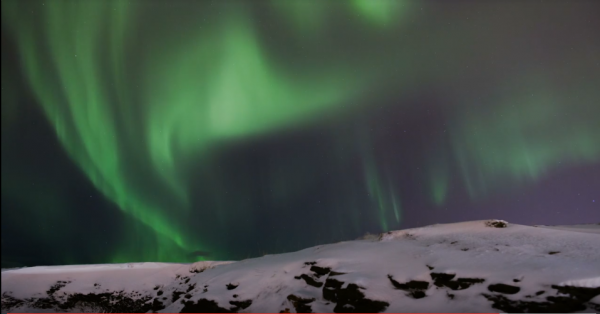
One of the most spectacular sights in Alaska is a good aurora show. Through a mix of science, art and traditional knowledge, a new film is casting the northern lights as something more than a mere novelty, as researchers try to tell a more comprehensive story about the phenomenon. The result is a dazzling glimpse of the northern lights — but without the cold.
From a comfortable chair inside the planetarium at the University of Alaska Anchorage campus, one can gaze up at an overhead dome as ribbons of green light dance above the North Slope.
“What are the Northern Lights?” narrator Patuk Glenn asked at the start of a new planetarium show. “How do they fit into the natural world? What meaning do they have for those who live beneath their splendor?”
A mix of time-lapsed aurora videos from around the state, interviews and different explanations for the phenomenon known as the northern lights comprise the 20 minutes of the film.
“According to the ancient oral tradition, the kiuġuyat, or northern lights, are the spirits of people playing a game of soccer in the sky.”
Some accounts are scarier.
“The lights are prone to swooping down to earth to cut off the heads of the unwary,” Glenn narrated in an even tone.
One of the stars of the movie is Fannie Akpik, an elder in Utqiaġvik. As a child, the warnings of decapitation were a way to kids into bed. At around 9:30 each evening, she recalled, children started to worry.
“‘The northern lights are out,'” Akpik said, imitating a kid.
“‘Guess what? They’re gonna chop your head off, and they’re gonna play with your head like a football,'” Akpik laughed.
Throughout interviews, other elders from Iñupiaq communities in the high north tell stories of using the lights for winter travel, or how they helped define the seasons of the year.
Recollections of the lived experiences under the auroras are augmented by a scientific accounting of why they happen in the first place, told through dynamic diagrams that look like a textbook coming to life.
The phenomenon starts with ejections from the surface of the sun that send charged particles hurtling through space.
“It takes one to four days for the highly charged solar particles to reach earth,” the narrator explained.
The earth’s magnetic field deflects most of that solar wind. But some of the particles get drawn toward the planet’s poles, colliding with atmospheric gases.
“The color of the lights depends on which types of gas the sun’s charged particles run into,” Glenn explained. “Green is most common, and is caused by energized oxygen.”
There’s something profoundly satisfying about hearing the particulars of astrophysics laid out with diagrams, while instantly seeing a 360-degree image of the twinkling phenomenon itself dancing over a dredge in Nome, or the snowy birch trees of the Interior.
Professor Travis Rector is a geophysicist at the university, and has a background in producing images of space that are science and art in equal measure. As part of a $1.4 million grant from the U.S. Department of Education he worked with partners to collect the images and stories that anchor the planetarium show.
“For a lot of people the aurora (are) just these pretty lights that we see in the sky every now and then, especially for us down here in Anchorage where we don’t see it as often,” Rector said, answering questions after a preview of the film. “But from the Interior and up on the North Slope, the aurora are a daily part of their lives and a part of their culture. So hearing the stories and learning about how they live the with auroras and how they use the auroras — that’s really remarkable.”
The movie itself is called Kiuġuyat, and it has a run at the UAA planetarium. But it’s also going to schools in the North Slope, Northwest Arctic and Bering Strait regions. Staff from the Geophysical Institute in Fairbanks have a traveling planetarium that one person described as similar to a large inflatable bounce-house with a projector inside, which they’ll be taking across the state.
The school showings are the point of the whole endeavor, according to Rector.
“The primary goal of the project is to share with Inupiat children their heritage of the aurora,” Rector said. “As time progresses these stories start to get lost and so making that connection between the stories of the elders and the children is the primary goal.”
The plan is to bring the Kiuġuyat show to every community in the Northwest Arctic and North Slope school districts, as well as to Nome, before the end of the school year. Aurora fans in Anchorage can see a screening at the UAA Planetarium on February 24th.
Or, you can test your luck outside.
Zachariah Hughes reports on city & state politics, arts & culture, drugs, and military affairs in Anchorage and South Central Alaska.
@ZachHughesAK About Zachariah




